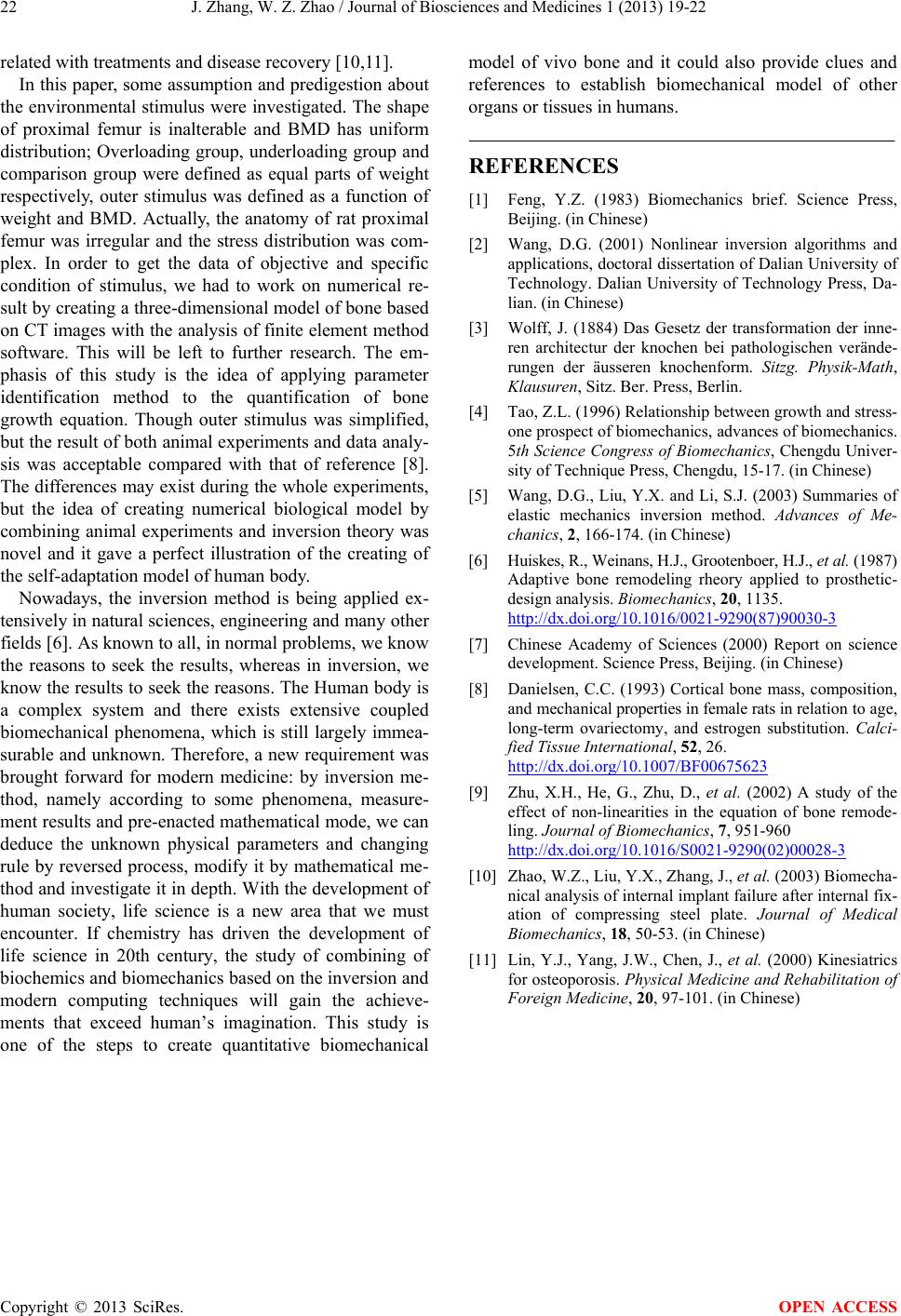
J. Zhang, W. Z. Zhao / Journal of Biosciences and Medicines 1 (2013) 19-22
Copyright © 2013 SciRes. OPEN ACCESS
related with treatments and disease recovery [10,11].
In this paper, some assumption and predigestion about
the environmental stimulus were investigated . The shape
of proximal femur is inalterable and BMD has uniform
distribution; Overloading group, underloading group and
comparison group were defined as equal parts of weight
respectively, outer stimulus was defined as a function of
weight and BMD. Actually, the anatomy of rat proximal
femur was irregular and the stress distribution was com-
plex. In order to get the data of objective and specific
condition of stimulus, we had to work on numerical re-
sult by creating a three -dimensional model of bone based
on CT images with the analysis of finite element method
software. This will be left to further research. The em-
phasis of this study is the idea of applying parameter
identification method to the quantification of bone
growth equation. Though outer stimulus was simplified,
but the result of both animal experiments and data analy-
sis was acceptable compared with that of reference [8].
The differences may exist during the whole experiments,
but the idea of creating numerical biological model by
combining animal experiments and inversion theory was
novel and it gave a perfect illustration of the creating of
the self-adaptation model of human body.
Nowadays, the inversion method is being applied ex-
tensively in natural sciences, engineering and many other
fields [6]. As known to all, in normal problems, we know
the reasons to seek the results, whereas in inversion, we
know the results to seek the reasons. The Human body is
a complex system and there exists extensive coupled
biomechanical phenomena, which is still largely immea-
surable and unknown. Therefore, a new requirement was
brought forward for modern medicine: by inversion me-
thod, namely according to some phenomena, measure-
ment results and pre-enacted mathematical mode, we can
deduce the unknown physical parameters and changing
rule by reversed process, modify it by mathematical me-
thod and investigate it in depth. With the development of
human society, life science is a new area that we must
encounter. If chemistry has driven the development of
life science in 20th century, the study of combining of
biochemics and biomechanics based on the inversion and
modern computing techniques will gain the achieve-
ments that exceed human’s imagination. This study is
one of the steps to create quantitative biomechanical
model of vivo bone and it could also provide clues and
references to establish biomechanical model of other
organs or t i s s u e s in humans.
REFERENCES
[1] Feng, Y.Z. (1983) Biomechanics brief. Science Press,
Beijing. (in Chines e)
[2] Wang, D.G. (2001) Nonlinear inversion algorithms and
applications, doctoral dissertation of Dalian University of
Technology. Dalian University of Technology Press, Da-
lian. (in Chinese)
[3] Wolff, J. (1884) Das Gesetz der transformation der inne-
ren architectur der knochen bei pathologischen verände-
rungen der äusseren knochenform. Sitzg. Physik-Math,
Klausuren, Sitz. Ber. Pres s, Berlin.
[4] Tao, Z.L. (1996) Relationship between growth and stress-
one prospect of biomechanics, advances of biomechanics.
5th Science Congress of Biomechanics, Chengdu Univer-
sity of Technique Press, Chengdu, 15-17. (in Chinese)
[5] Wang, D.G., Liu, Y.X. and Li, S.J. (2003) Summaries of
elastic mechanics inversion method. Advances of Me-
chanics, 2, 166-174. (in Chinese)
[6] Huiskes, R., Weinans, H.J., Grootenboer, H.J., et al. (1987)
Adaptive bone remodeling rheory applied to prosthetic-
design analysis. Biomechanics, 20, 1135.
http://dx.doi.org/10.1016/0021-9290(87)90030-3
[7] Chinese Academy of Sciences (2000) Report on science
development. Science Press, Beijing. (in Chinese)
[8] Danielsen, C.C. (1993) Cortical bone mass, composition,
and mechanical properties in female rats in relation to age,
long-term ovariectomy, and estrogen substitution. Calci-
fied Tissue International, 52, 26.
http://dx.doi.org/10.1007/BF00675623
[9] Zhu, X.H., He, G., Zhu, D., et al. (2002) A study of the
effect of non-linearities in the equation of bone remode-
ling. Journal of Biomechanics, 7, 951-960
http://dx.doi.org/10.1016/S0021-9290(02)00028-3
[10] Zhao, W.Z., Liu, Y.X., Zhang, J., et al. (2003) Biomecha-
nical analysis of internal implant failure after internal fix-
ation of compressing steel plate. Journal of Medical
Biomechanics, 18, 50-53. (in Chinese)
[11] Lin, Y.J., Yang, J.W., Chen, J., et al. (2000) Kinesiatrics
for osteoporosis. Physical Medicine and Rehabilitation of
Foreign Medicine, 20, 97-101. (in Chinese)